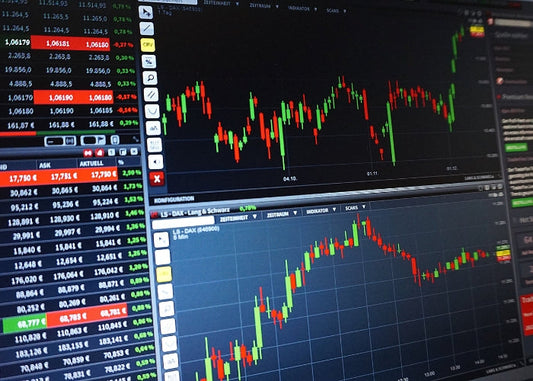Trading - seize opportunities and hedge against falling prices

Trading vs. investing
The capital markets are full of players with very different objectives. Essentially, there are two main types of market participants, investors, and traders. While they all have in common that they want to earn money, these two groups differ significantly in their approach and especially in the time horizon that underlies their investment decisions.
Investors make long-term investment decisions with time horizons of years or decades. For them, therefore, long-term orientation and development are strongly in the foreground when selecting potential investment objects. A widespread method related to this is so-called value investing. The term was coined to a large extent by the investor and economist Benjamin Graham (1894 to 1976), who is considered the father of fundamental securities analysis.
As the latter already indicates, value investing is about examining the fundamental factors that have a very significant influence on the long-term success of a company. Another key feature of value investing is its anti-cyclical approach. Value investors will only invest if they consider it favorable in terms of expectations of future returns. Value investors pay particular attention to the balance sheet structure and earnings analysis, for example. Fundamental indicators such as the price/earnings ratio (P/E ratio) or the dividend yield serve as a guide to whether an investment is cheap or expensive.
Traders, on the other hand, prefer a short- to the medium-term investment horizon. In the most extreme forms of day trading, for example, the average holding period is a few seconds or minutes (scalping). Medium-term-oriented traders hold their positions for several days, up to several weeks or months (position trading). The shorter the investment horizon, the less relevant is usually the fundamental situation of the company or the underlying asset, which can also be a currency or a commodity.
Traders are therefore often guided by technical analysis. They often use price charts or indicators as supplementary means but also short-term news that moves the price. It is impossible to go into all existing trading strategies at this point. However, we would like to give you a general overview of the different types of trading strategies:
Trend following
Trend following systems belong to the cyclically focused trading approaches and are very technically oriented. Usually, price charts are used to identify trends. So-called momentum strategies are among the most popular strategies of this type. The art of these strategies is to determine the right moment to exit.
Trend reversal or anticyclical trading
As the name suggests, market participants in this approach try to find the perfect moment for a trend reversal in order to participate in the expected upward movement. The challenge with this strategy is to buy when the majority of other market participants are selling out of fear. A piece of good knowledge about the fundamental situation and the relative value is crucial for this strategy. Chart analysis is often used for support.
Event-based trading
This refers to strategies that profit from price movements triggered by a specific event. Triggers can be a variety of different events such as interest rate decisions by central banks, company reports, economic data, and similar. The basic assumption is usually that the event results in a strong price movement. The implementation is often done using derivatives and other leveraged products.Arbitrage
is a general term for a number of strategies, which are mainly used by institutional investors, not least because the capital required is usually enormous and the technical requirements are a barrier. The profits are typically very small in relation to the investment, but on the other hand, they mostly offer a very low risk of loss. Probably the most popular type of arbitrage is to use fully automated trading systems to identify and exploit price differences in an underlying asset on different stock exchanges within milliseconds.
Market neutral strategies
Market neutral strategies are bi-directional trading approaches in which the investor benefits from both rising and falling prices. This can be done in a variety of ways. Popular trading approaches in this context are, for example, equity or commodity long/short strategies, in which one tries to profitably trade the spread (price difference) of two highly correlated underlying by buying one position and selling the other. Other market-neutral strategies can be found, for example, in the context with options trading.
Automated trading
Computer-controlled and fully automated trading algorithms are becoming increasingly popular in the age of information technology and are also being used more and more frequently by small investors. Those who have the appropriate trading software and are connected to a broker that supports fully automated order entry can choose from a variety of freely available trading algorithms that they find most profitable. The great advantage of automated trading is that it takes less time and eliminates human emotions like fear or greed as risk factors.
Social Trading/Investing
This fairly new type of investment strategy aims to follow in the footsteps of those who have already proven that they are capable of making steady profits in the stock market. With the invested capital, every investment decision of the trader is followed, and in the case of profits, of course, a commission is due. For very uncertain or inexperienced traders, this can be a way to invest profitably without taking unmanageable risks.

Trading psychology
A crucial factor in trading is one's own mindset and the ability to control the own emotions in order to prevent them from influencing investment decisions. Euphoria and overconfidence as well as fear and uncertainty can have a significant impact on the success of trading. It is therefore extremely important to create your own rules and principles as a guideline in order to have a clear strategy. One of the most important things in this regard is the clear limitation of losses and solid money management. Position sizes should always be aligned with the size of one's own account.
How do you protect yourself against losses?
There are different methods to protect yourself against losses. One of them, as already mentioned, is to clearly limit losses, for example by using stop-loss orders. This means that when the price falls under a certain level, a sell order is placed. If the market does not fall too quickly and massively, generally the loss can be limited quite sharply using this method.
Another form of loss limitation can be to hedge one's own stock positions with a counter-position. The hedging instrument can be short CFDs or put options, for example. This approach can be beneficial for those who do not actually want to sell their shares. For example, the owner of a large number of shares with voting rights, who can use them to significantly influence the decisions of the company, will not decide to sell his share position due to short-term turbulence. The same may apply to those who receive a significant part of their income from dividends. In addition, the sale of all shares is associated with high costs, especially compared to a single hedging position, which is usually cheaper than selling all shares.
Also suitable as a means of choice is a short sale, in which one borrows a share and sells it on the market in order to buy it back at a lower price. All of the methods mentioned can be used to profit from falling share prices. It is important to know that positions speculating on falling prices include financing costs in the form of borrowing fees. In addition, positions on falling prices are subject to the unlimited risk of loss. It is therefore important to adjust the size of the position to the position you want to hedge.
No comments
Home
Trive
TriveHub





0 comments